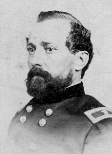 Open main menu
Open main menu
 Open main menu
Open main menu

J. Reno
(1823 - 1862)
Home State: Pennsylvania
Education: US Military Academy, West Point, NY, Class of 1846;Class Rank: 8/59
Command Billet: Army Corps Commander
Branch of Service: Infantry
Unit: Ninth Army Corps
Before Antietam
He served in the Mexican War following graduation from West Point and was seriously wounded at Chapultepec, where he commanded a howitzer battery. After Mexico he was assistant professor of mathematics at the US Military Academy from January till July 1849, secretary of a board to prepare a "system of instruction for heavy artillery (1849-50), assistant to the ordnance board at the Washington (DC) Arsenal (1851-53), and on topographical duty in Minnesota (1853-54). He was chief of ordnance on the Utah Expedition of 1857-59 then in command of the Mount Vernon Arsenal at Mobile, AL until its seizure by the Confederates in January 1861.
On 1 July 1860 he was promoted to Captain for fourteen years' continuous service. From 2 February till 6 December 1861 he was in command of the arsenal at Leavenworth, Kansas. He was appointed Brigadier General of Volunteers on 12 November 1861 and was in command of the 2nd Brigade during General Ambrose E. Burnside's expedition into North Carolina.
From April till August 1862, he commanded a division in the Department of North Carolina and on 18 July he was commissioned Major-General of Volunteers. In the campaign in northern Virginia in August he led the Ninth Army Corps, and took part under General John Pope in the battles of Manassas and Chantilly.
On the Campaign
He was in command of the Ninth Corps on the campaign and was mortally wounded on the evening of 14 September 1862 on South Mountain, shot in the chest while attempting to re-start his Corps' stalled assault in person at Fox's Gap. He died nearby shortly afterward.
Reno thought he'd been accidentally shot by one of his own men due to darkness, specifically by a member of the 35th Massachusetts Infantry, but battle historian Ezra Carman, going by veteran accounts, has him hit by gunfire from Confederates of Hood's Division in the woods opposite. Alternately, Confederate General D.H. Hill reported that the shot came from the 23rd North Carolina of Garland's Brigade, which is less likely.
References & notes
His bio and service basics from Appleton's,1 with death details from Carman.2 Personal details from family genealogists and the US Census of 1860. His gravesite is on Findagrave; he was originally buried at the Trinity Church in Boston, but was removed to Oak Hill in 1867. His picture from a photograph at the Library of Congress. Thanks to Jim Steele for the poke to improve the General's profile.
He married Mary Bradley Beanes Cross (1828-1880) in Washington, DC in October 1853 and they had 5 sons; the first died at age 8, the next 2 died as infants. Her father Trueman Cross was a career Army officer; a Colonel and Assistant Quartermaster General when he was killed by "Mexican bandits" near Fort Brown, TX in April 1846.
More on the Web
Reno, Nevada and a number of other places, including a fort in the defenses of Washington, DC (now Fort Reno Park), were named for the fallen general.
There is a monument to him at Fox's Gap on South Mountain.
Birth
04/20/1823; Wheeling, VA
Death
09/14/1862; near Fox's Gap, MD; burial in Oak Hill Cemetery, Washington, DC
1 Fiske, John, and James Grant Wilson, editors, Appleton's Cyclopedia of American Biography, 6 vols., New York City: D. Appleton and Company, 1887-1889, Vol. 5, pp. 221-222 [AotW citation 30856]
2 Carman, Ezra Ayers, and Dr. Thomas G. Clemens, editor, The Maryland Campaign of September 1862, 3 volumes, El Dorado Hills (CA): Savas Beatie, 2010-17, Vol. 1, p. 343 [AotW citation 30857]